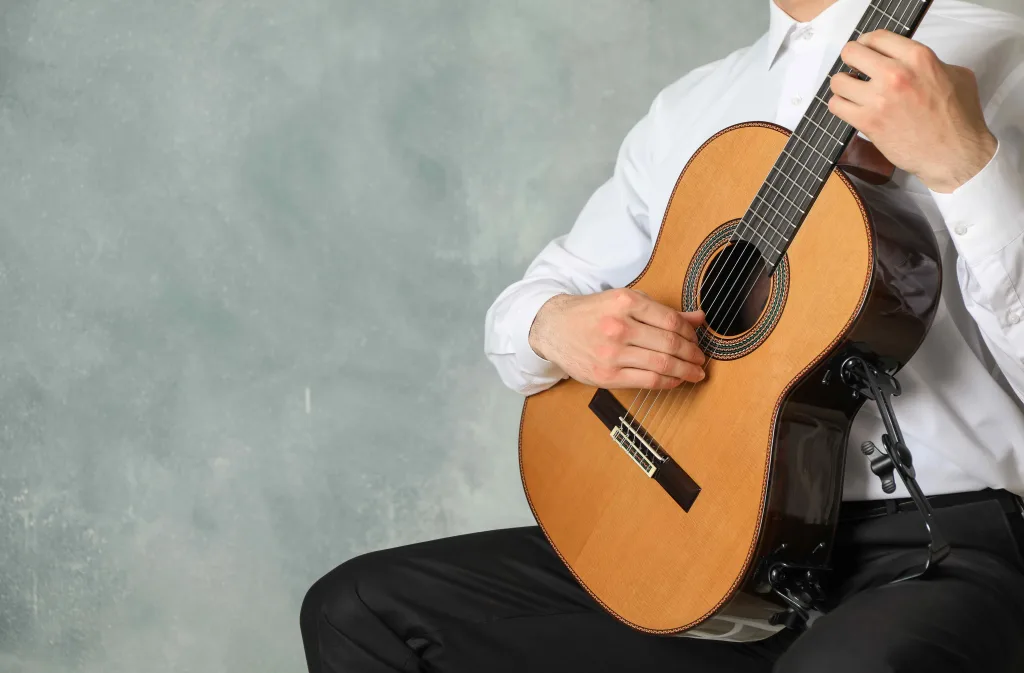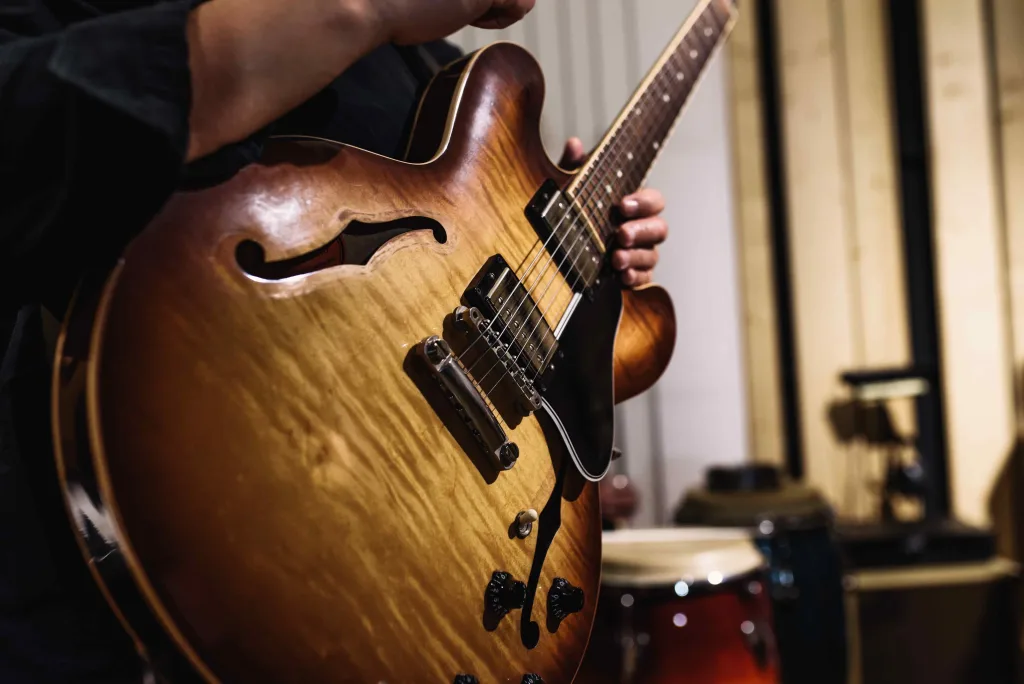If you’re passionate about folk music or looking to explore different guitar styles, you may have come across the term “folk guitar.”
But what exactly is a folk guitar?
In this article, we’ll dive into the world of folk guitars, exploring their definition, strings, playing styles, and the differences between folk and acoustic guitars. This article will provide you with valuable insights into the captivating realm of folk guitars.
What Exactly is a Folk Guitar?
A folk guitar is typically a small to mid-sized acoustic or acoustic-electric guitar with steel strings commonly used in folk music. However, it’s worth noting that many folk players have also utilized larger guitars based on their personal preferences.
Unlike other guitar styles, there isn’t a standard folk guitar. The choice of a guitar depends on the specific folk style you’re interested in.
What is a Folk Music?
Folk music is a genre that includes both traditional and modern styles. It originated from traditional music passed down through generations and experienced a revival in the 20th century. It includes a wide range of music from different cultures around the world.
What are Folk Guitar Strings?
The folk guitar strings play a crucial role in determining the tone. Folk guitar strings are generally thinner than acoustic guitar strings, giving them a distinct sound.
If you’re looking to change your guitar strings to folk guitar strings, you’ll need phosphor bronze acoustic strings. These strings offer a softer and mellower tone compared to 80/20 bronze strings.
For an even softer tone, you can opt for “silk and steel” strings. These strings have a polyester layer between the winding and steel core, acting as a cushion and making them sound soft.
Additionally, silk and steel strings help prevent callouses on your fingers, which can be beneficial for beginners who find pressing against hard steel strings challenging.

Folk Music Guitar-Playing Styles
Folk and folk-rock guitar playing styles are often perceived as straightforward, but that doesn’t mean they don’t require skill and practice. While folk is a broad term encompassing various subgenres, folk guitar playing predominantly relies on fingerpicking and strumming techniques. These seemingly simple techniques can be more challenging than anticipated.
Strumming patterns, for example, go beyond basic beginner techniques, requiring precision and rhythmic control. Fingerpicking, on the other hand, can become quite intricate. It involves plucking individual strings with the fingers, allowing for intricate melodies and chord progressions.
Differences between Folk and Acoustic Guitar
There are a few differences between folk and acoustic guitar, although they may seem alike to some.
Let’s explore the differences between the two guitar types.
Differences in Size
Most folk guitars are smaller than full-size guitars. However, it’s important to note that acoustic guitars come in different sizes as well, so size alone isn’t a defining characteristic of a folk guitar.
Differences in The Headstock
One noticeable difference between a folk guitar and a regular acoustic guitar is the appearance of the headstock. Folk guitars often feature different tuning pegs at the top compared to acoustic guitars.
Differences in Tone
Folk guitars produce a softer tone compared to acoustic guitars. This is primarily due to their thinner strings. Additionally, the smaller body of a folk guitar restricts its ability to produce a more expansive sound. Acoustic guitars, in contrast, are often equipped with a pickguard, as they are designed for strumming with a pick. Folk guitars, however, are better suited for fingerstyle playing.
In summary, while it’s possible to play folk songs on an acoustic guitar, the sound may not be as authentic. Folk guitars excel at fingerpicking techniques and are commonly associated with acoustic guitar playing. If you’re interested in learning fingerpicking techniques, a folk guitar would be a suitable choice.
By positioning your thumb on the bottom three strings and the other fingers on the top three strings, you can easily play arpeggiated chords, melodies, and chord progressions simultaneously.
Famous Folk and Folk-Rock Guitar Players

There are several famous folk and folk-rock guitar players that definitely worth mentioning:
- Bob Dylan
- Chet Atkins
- Paul Simon
- Tommy Emmanuel
- Nick Drake
- Jake Holmes
Popular Folk Guitars
If you’re looking for a folk guitar, here are some highly regarded options that have been favored by renowned artists:
Yamaha Acoustic FG720S
The Yamaha Acoustic FG720S not only boasts a mellow and pleasant tone but is also surprisingly affordable.
The FG in the name stands for “folk guitar.” It offers a great sound and was even played by Paul Simon on the recording of “Sound of Silence.”
Martin 0-45
The Martin 0-45 has been used by numerous musicians, including Paul Simon, Neil Young, Bob Dylan, and Joan Baez. It features a spectacular design, comfortable playability, and a remarkable tone.
Joan Baez particularly favored this guitar, despite its smaller 3/4 size. However, it’s worth noting that the Martin 0-45 can be quieter than larger guitars, requiring greater finger strength to achieve a louder sound. As Martin no longer produces these models, a suitable alternative is the Martin 0-28.
Taylor 714ce
The Taylor 714ce delivers exceptional sound quality and provides everything you need in a folk guitar, despite being on the higher end of the price range.
Conclusion
To sum it up, folk guitars open the door to a world of beautiful traditional and modern folk music. Whether you strum or use your fingers, these guitars create lovely melodies and catchy rhythms. Embrace the charm of folk guitars and start your musical adventure today.
If you want to learn more about different guitar types, read our article Different Types of Guitars – A Complete Guide
When it comes to guitars, there are countless varieties to choose from, each with its own unique sound and characteristics. Among these, the archtop guitar stands out as an iconic instrument with a rich history and distinctive tonal qualities.
In this article, we will delve into the world of archtop guitars, exploring their origin, construction, differences from flat tops, popularity in jazz music, and some popular models worth considering.
Whether you’re a seasoned guitarist or a music enthusiast, understanding the archtop guitar will deepen your appreciation for this classic instrument.
A Brief History of the Archtop Guitar
The archtop guitar’s history traces back to the early 20th century when jazz orchestras sought a transition from banjos to guitars. Regular flattop guitars of the time weren’t loud enough to be heard over the ensemble.
Orville Gibson, the inventor of the archtop guitar, believed he could enhance the guitar’s volume by curving the top, similar to a violin’s design. He used wood to carve the top and increased the guitar’s size to produce a more resonant sound.
Over time, archtop guitars have different transformations, including the addition of cutaways to allow guitarists to reach higher frets.
With the emergence of jazz guitarists like Charlie Christian and Wes Montgomery, the archtop guitar gained immense popularity.
Christian’s influence, in particular, solidified the archtop as a staple in jazz music, and its distinct tone became highly associated with the genre.
You can learn more about guitar history in our article The History of the Guitar.
Construction of an Archtop Guitar
Archtop guitars typically feature three-a-side pegheads and necks with a width resembling that of a steel-string acoustic rather than an electric guitar. High-end models often have “block” or “trapezoid” position markers for added elegance.
The top or belly of the archtop guitar can be crafted by either carving a solid block of wood or heat-pressing it using solid top or laminated construction techniques.
The belly usually has two f-holes, which are partially covered by a raised scratch plate to avoid dampening the vibration. The design of the arching profile is often done in an ad hoc fashion, and the f-holes and arching are reminiscent of the violin family, from which they were originally derived.
The choice of wood for the resonant top of archtop guitars includes Sitka spruce, European spruce, Engelmann spruce, Adirondack spruce (Red spruce), or Western red cedar. Additionally, archtop guitars often feature Curly maple or Quilted maple backs.
These guitars can be quite large, with the width of the lower bout sometimes approaching 19 inches (47 cm).
While the original acoustic archtop guitars were designed for use with relatively heavy strings to enhance volume, modern jazz guitarists still prefer heavier strings (0.012″ gauge or heavier) for tonal reasons and often opt for flatwound strings. Thinline archtops, on the other hand, typically use standard electric guitar strings.

Why Archtop Guitars Have Soundposts?
A soundpost, commonly found in string instruments like violins and mandolins, serves to transfer vibrations within the instrument. In the case of archtop guitars, the soundpost serves both as structural support and as a means to transfer sound from the top plate to the backplate.
Soundposts also play a role in altering the sound produced by the instrument by influencing the vibrational modes of the plates, contributing to the guitar’s overall tonal qualities.
Differences Between Archtops and Flat Tops Guitars
The term “archtop” contains both acoustic and electric archtop guitars, which are sometimes referred to as semi-acoustic guitars due to their similar uses. The most apparent distinction lies in their physical appearance and sound.
Archtop guitars feature a curved body and f-shaped soundholes, typically located on the treble and bass sides of the instrument. They offer better vibrations and tension relief.
Conversely, flat-top guitars are standard acoustic guitars with a central soundhole and internal bracing.
In terms of tone, flat tops produce a shimmering and bright resonance, while archtops deliver a mellower, rounder sound akin to a solid-body electric guitar. This characteristic makes archtops well-suited for playing blues and jazz music.
Regarding volume, archtops are generally louder than flat tops. Consequently, many archtop guitars are used as electric instruments, with their sound amplified through an amplifier.

What Makes Archtop Guitars Popular for Jazz Music?
Although jazz music can be played on various guitar types, the archtop guitar became synonymous with jazz due to its historical association with iconic jazz guitarists and its unique tonal qualities.
Unlike flat tops, archtops’ sound isn’t hindered by braces or bridges, allowing for enhanced volume and a distinctive punchy sound.
The curved body design further contributes to better projection and a warm, resonant tone, making it a perfect fit for the nuances of jazz music.
Jazz enthusiasts often opt for archtop or semi-hollow body guitars because of their warmer, jazzier sound, which perfectly complements the genre’s expressive nature.
Popular Archtop Guitars
If you’re considering getting your hands on an archtop guitar, here are some popular models worth exploring:
- D’Angelico Premier EXL-1 Electric Guitar: D’Angelico Guitars has a long-standing reputation for producing top-quality instruments. The Premier EXL-1 is a hollow-body electric guitar with a single cutaway, a rosewood fretboard, and a maple neck. Despite having a single pickup, it still delivers a punchy and warm sound ideal for jazz.
- Gretsch G100CE Acoustic-Electric Guitar: Gretsch, a renowned guitar-producing company, offers the G100CE, an electric, hollow-body archtop guitar with vintage style and excellent playability. Its mellow tone makes it a perfect choice for jazz enthusiasts.
- Eastman AR503CE Electric Archtop Guitar: Known for their quality handmade guitars, Eastman offers the AR503CE, an electric archtop guitar with a single-cutaway design and a deep, resonant, and articulate sound perfect for jazz lovers.
Conclusion
The archtop guitar holds a special place in the world of music, particularly in the realm of jazz. Its unique construction, warm and resonant tone, and historical significance have made it a favorite among musicians and enthusiasts alike.
Whether you’re a jazz enthusiast or just appreciate the beauty of a well-crafted instrument, the archtop guitar is a timeless classic that continues to captivate and inspire generations of musicians.

